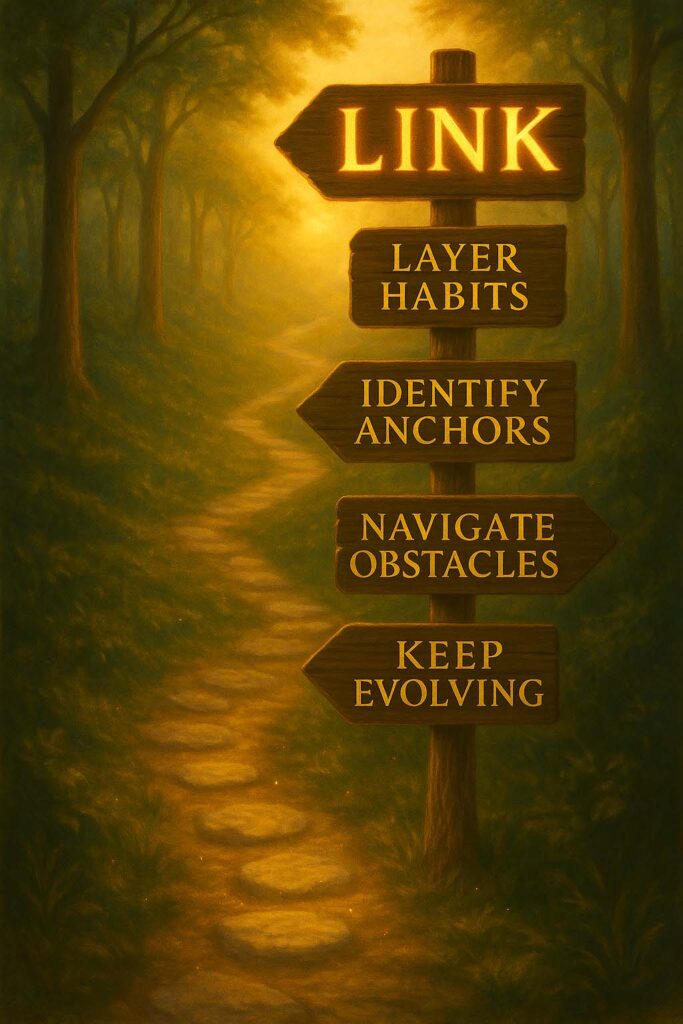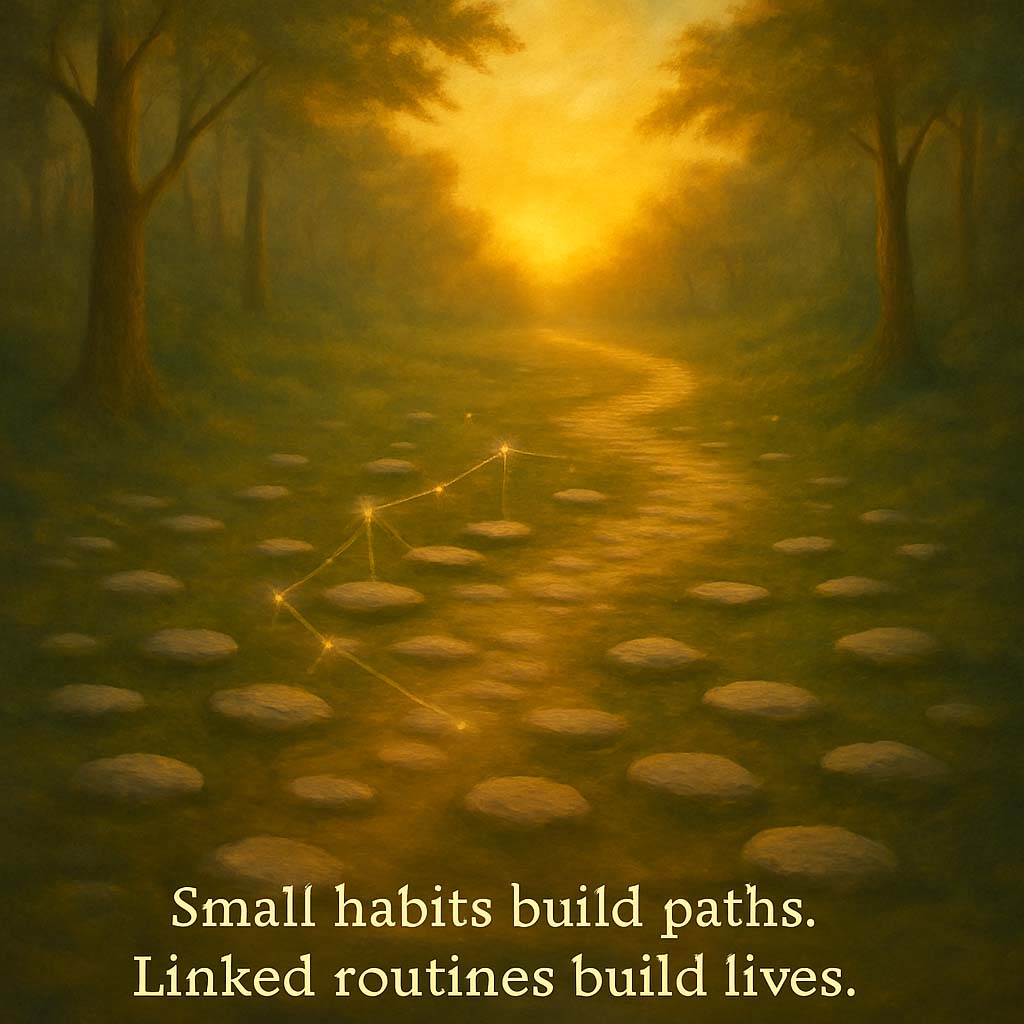
🔗 Unite
Layered steps. Lasting change. Flow you can trust.
You’ve planted small habits through Optimise.
Now it’s time to Unite — gently linking those habits into steady daily routines that carry you forward, even when motivation fades.
In the Unite phase, we use the LINK framework to build real-world ADHD-friendly routines: flexible, anchored, and adaptive.
Because when habits work together, they stop feeling like effort — and start feeling like flow.


🌿 Why Routines Matter
Daily routines aren't just about "being organised."
They are scaffolds for stability, focus, and emotional regulation — especially for ADHD minds that naturally crave novelty, spontaneity, and stimulation.
Here’s why routines are crucial:
- 🔄 They reduce decision fatigue. You don’t have to constantly think, "What should I do next?" The next action is already woven into your day.
- ⚡ They leverage the power of habit loops. Small cues trigger familiar behaviors automatically, freeing your mental energy for creativity, learning, and deeper work.
- 🧠 They support dopamine regulation. Every small completed action in a routine delivers a mini reward — a microburst of dopamine — reinforcing your positive momentum without relying on sheer willpower.
- 🧩 They create predictability in a world of mental noise. For ADHD brains, routines act like gentle rails — guiding you when your attention wants to scatter.
When habits are isolated, they are easier to forget.
When habits are linked into living routines, they become self-sustaining — a natural part of your landscape.
🌟 How Unite Builds on HABIT
In Optimise, you built individual habits: Sleep earlier. Prep your workspace. Pause before reacting.
Now, in Unite, you weave these habits together:
- A morning flow that carries you from wake-up to work.
- An evening flow that winds you down peacefully.
- A study flow that helps you start, sustain, and finish tasks.
It’s like assembling the stepping stones you carefully placed in Optimise — into a strong, beautiful path you can walk daily. You’re not building routines by forcing them. You're LINKing them naturally, using the science of habit formation, habit stacking, cue anchoring, and flexible adaptation — all made ADHD-smart.
"Small habits build paths. Linked routines build lives."


🌿 L — Layer Habits
Start with one manageable habit — then gently stack another.
This is the heart of habit stacking, a proven technique from Atomic Habits and behavioral science: small actions naturally cue the next.
Instead of trying to build big routines overnight (which can overwhelm ADHD brains), you craft simple, connected sequences.
One step triggers the next without needing heavy mental effort.
✨ Example:
- After pouring your morning coffee (existing habit), immediately review your top 3 priorities for the day (new habit).
- After brushing teeth, put out gym clothes for the next morning.
🔬 Science Insight:
Habit stacking uses contextual cues — actions already embedded in your day — to make starting new behaviors nearly frictionless.
This helps ADHD minds bypass the "blank slate" struggle of figuring out "what next?"
Small links grow strong trails.

🌿 I — Identify Anchors
Habits stick better when attached to stable, recurring events in your natural rhythm:
# Waking up
# Eating Meals
# Finishing work
# Brushing teeth
# Going to bed
We call these anchors — fixed points in your day that can cue the next positive action almost automatically.
✨ Example:
- After breakfast (anchor), open your planner for a 2-minute check-in.
- After putting on pajamas (anchor), do 5 minutes of stretching.
🔬 Science Insight:
Implementation intentions (If X, then Y) strengthen habit reliability by embedding "trigger-action" links into daily life, reducing the need for motivation at the moment. Anchor habits to your real rhythm — not an idealized perfect schedule.

🌿 N — Navigate Obstacles
Routines don’t fall apart because you're "lazy" — they collapse when unexpected friction points appear.
✨ Examples of Friction Points:
- Planner buried under laundry → no daily review.
- Meditation app buried on page 7 of your phone → forgotten.
- Bedtime scrolling temptation → wind-down routine derailed.
Key strategy: Design your environment to support success.
• Make helpful behaviors obvious and easy (planner open on your desk).
• Make distractions harder to reach (social media apps off home screen).
🔬 Science Insight:
Behavioral psychology shows that even tiny increases in friction (like 10 extra seconds to access social media) drastically decrease impulsive actions — crucial for ADHD management.
🧩 Instead of abandoning routines when obstacles appear, adjust the trail gently.

🌿 K — Keep Evolving
Routines are living systems — just like you.
You don’t set a perfect routine once and forever.
Instead, you learn to adapt as life shifts:
• New job → new sleep schedule.
• Seasonal mood changes → new self-care habits.
• New interests → new anchors.
✨ Examples:
- Shift your study block earlier if evening focus fades.
- Add a 5-minute pause between work and home routines to transition calmly.
🔬 Science Insight:
Neuroplasticity means your brain continuously adapts to patterns you reinforce — evolving your routines to match your needs helps reinforce them more deeply.
Flexible routines = resilient habits = sustainable growth.
🌱 Growth isn't rigid. It flows. Keep evolving.


☀️ Building a Morning Routine
Goal: Start the day with clarity and energy.
Layer habits:
- Wake up → Open curtains → Stretch → Drink water → Review top 3 priorities → Begin a focus sprint.
Identify anchors:
- Cue = Opening the curtains.
Navigate obstacles:
- If you hit snooze → Use an automatic sunrise alarm to support natural wake-up.
Keep evolving:
- Adjust stretch time or focus sprint if morning schedules change.
🌙 Repairing an Evening Routine
Goal: Wind down without nighttime overwhelm.
Layer habits:
Finish dinner → Place phone in "charging basket" → Change into pyjamas → Read calming book.
Identify anchors:
Cue = Putting the phone away after dinner.
Navigate obstacles:
If scrolling temptation hits → Use app limits or buddy accountability.
Keep evolving:
Adjust reading time flexibly if evenings become busier.


🎯 Tools for Linking Habits Together
Building reliable routines isn’t about "trying harder."
It’s about designing smarter.
Here’s how you can LINK habits into flows that work for your ADHD brain — not against it:
🔗 Habit Stacking:
Anchor new habits onto existing ones.
When a habit follows a familiar anchor, your brain doesn't need to "decide" anymore — it flows naturally.
Example: After pouring my morning coffee, I review my planner for 1 minute.
🔗 Implementation Intentions:
Pre-plan actions based on real-life triggers.
"If X happens, then I do Y" helps the brain recognize moments for action automatically.
Example: If I close my laptop at 5PM, I stretch for 2 minutes.
🔗 Temptation Bundling:
Pair less exciting habits with enjoyable rewards.
Dopamine isn’t the enemy — it’s a tool! Bundle tasks so your brain wants to show up.
Example: Listen to your favorite podcast only during a 10-minute walk.
🔗 Environmental Design:
Make good habits obvious, easy, and satisfying — and bad habits invisible or difficult.
ADHD brains are sensitive to friction and temptation. Prime your spaces thoughtfully.
Example:
– Place your journal and pen on your pillow (so you reflect before bed).
– Move distracting apps off your home screen (so friction slows impulsive scrolling).
🔗 Visual and Physical Cues:
Use timers, alarms, sticky notes, and visual anchors.
External prompts help bridge memory gaps and task initiation struggles common in ADHD.
🔗 Tiny Tracking and Rewards:
Celebrate the link, not just the outcome.
Each time you connect a habit, acknowledge it. Dopamine builds stronger circuits when small wins are celebrated.
Tip:
Use the Safe Life Guide app’s Habit Tracker to watch your habits flow together — one link at a time.
🔗 Friction Navigation:
Adjust your path when obstacles appear — without self-criticism.
In ADHD, routines often break because of friction, not failure. Small repairs keep the routine alive.
🧠 Why This Matters for ADHD:
- Dopamine pathways strengthen when rewards are immediate and clear.
- Habits linked to strong, stable cues (anchors) prevent forgetting and procrastination.
- Small friction (like a hidden notebook) causes big derailments — fixing the environment supports consistency.
- Linked routines reduce the burden of constant executive function decisions ("What do I do next?").
✨ Summary: Linking is not about perfect discipline. It’s about building real-life bridges — small, satisfying, supported steps — so that habits move together naturally, even on days when focus is hard. Small habits build paths. Linked routines build lives.

🌿 Growing a Living Routine
Linking habits isn’t about rigid checklists.
It’s about building flowing, resilient trails that work with your mind — not against it.
Small steps. Natural anchors. Gentle adjustments.
Start small. Stay steady. LINK your life together, one choice at a time.
📜 Final Encouragement
"Pick two habits you already love — and gently LINK them today.
Small connections grow strong over time."
🔗 Start Linking Your Habits Today

Mon - Fri: 8AM - 6PM
Sat - Sun: Variable
Brisbane North Medical Specialists,
15 Dallas Parade, Keperra, QLD 4054
(07) 5221 3489
reception@bnms.com.au
